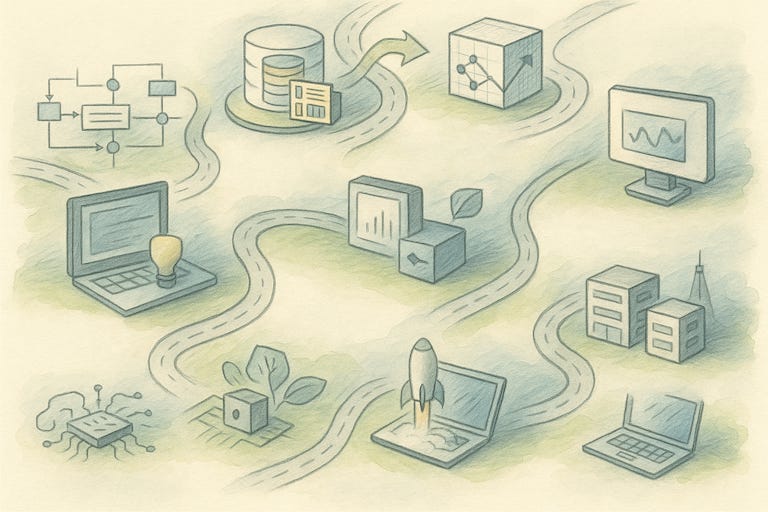Startup Tracker #1 - What this week's infra moves reveal
Twelve currents reshaping the AI infra stack
I analyzed the movement of 250 infra startups over the last week. The signals cluster into 12 investable themes. Each theme reflects where capital, engineering talent, and customer demand are converging. Together they outline the stack that will underwrite AI-native software over the next 24 months.
I’ve analyzed each theme below covering the thesis, the core product direction, and the forward-looking trade we’d put on.
1. Agent-Oriented Orchestration Layers
Thesis: Long-running, multi-step agent workflows are replacing one-shot API calls.
Product direction: Temporal, Adept, Dust, and Inflection are hardening orchestration engines (stateful workflows, action graphs, replay) so enterprises can treat agents as reliable microservices.
Trade: Picks-and-shovels that expose deterministic replay and policy controls will have the upper hand. Monolithic copilots that can’t externalize state will have a hard time.
2. Multimodal and Domain-Specific Data Stores
Thesis: Horizontal warehouses are ceding ground to modality-aware stores that combine vector, blob, and structured indexes.
Product direction: ApertureData (visual DB), Twelve Labs (video understanding), and Turso (serverless MySQL variants) optimize for high speed (single-digit-ms) hybrid queries.
Trade: Overweight specialized stores that sit closest to model retrieval loops. Underweight generic data lakes without modality metadata.
3. Inference and Deployment Commoditization
Thesis: The “Platform-as-a-Service for models” layer is crowding fast.
Product direction: Seldon, Baseten, Banana.dev, Modular, and Replicate provide autoscaling GPU pods, model registries and SOC2 envelopes out-of-the-box. Differentiation is shifting to latency and cost per token.
Trade: Vendors with hardware abstraction + cost-aware schedulers look strong. Pure hosting plays with no scheduling IP will have a tough time.
4. Vector Search Becomes Table-Stakes
Thesis: Embedding indices are now assumed plumbing, not an optional add-on.
Product direction: Pinecone-style services are being embedded directly inside general databases (RisingWave, ClickHouse, Materialize) and data-activation layers (Hightouch).
Trade: There will be margin compression for standalone vector databases unless they own adjacent tooling (RAG orchestration, hybrid ANN tuning).
5. Data Activation and Reverse ETL 2.0
Thesis: The activation layer is moving from batch syncs to real-time “feature buses”.
Product direction: Hightouch and Featureform are embedding streaming transformations, fine-grained governance, and lineage so operational tools can subscribe to fresh features within seconds.
Trade: This should be paired with going long on streaming compute (Materialize, RisingWave).
6. AI-Native Observability and Trust
Thesis: Enterprises now budget for LLM analytics just like APM a decade ago.
Product direction: Fiddler, Arize, Superwise, Cleanlab, and Galileo track token-level drift, outlier prompts and explanation metrics. New entrants add cryptographic attestations.
Trade: These tooling vendors will gain the upperhand as compliance tailwinds (EU AI Act, NY DFS) lock them in. Legacy APM companies that bolted on superficial LLM dashboards might face a tough time.
7. Security, Governance and Policy as Code for AI
Thesis: Every infra layer is being rewritten with least-privilege, usage-logging, and policy hooks baked in.
Product direction: Oso (authorization as code) and Paravision (AI identity) extend zero-trust to model outputs and agent actions.
Trade: Companies building tooling around attestation standards (DID, VC) will have an advantage. Monitor M&A from cloud-security majors.
8. Developer Productivity and Code Intelligence
Thesis: IDEs are morphing into command centers for orchestrating fleets of copilots.
Product direction: Replit, Cursor, Zed, Continue, and Stenography surface offline embeddings, speculative execution, and repo-scale RAG. The moat is context window management, not chat UI.
Trade: Go long on platforms with local-first embeddings that reduce token spend. Thin wrapper browser extensions will face trouble.
9. Synthetic and Privacy-Preserving Data Engines
Thesis: Data scarcity and privacy regulation fuel synthetic pipelines.
Product direction: Mostly AI, Datagen and Cleanlab auto-generate labelled corpora with differential privacy and bias tuning knobs.
Trade: Buy the suppliers enabling vertical SaaS teams to dodge data-collection bottlenecks.
10. Compute Optimization and Specialized Silicon
Thesis: As model sizes plateau, ROI shifts to throughput-per-watt and memory bandwidth.
Product direction: Rain AI (neuromorphic), SambaNova (RDU), Modular (Mojo + inference compiler) promise 3-10x TCO cuts via custom compilers and sparsity tricks.
Trade: Compiler companies with HW-agnostic MLIR (Multi-Level Intermediate Representation) stacks will have an upper hand. Watch for consolidation as hyperscalers hoover niche ASICs.
11. Edge and Real-Time Streaming Infrastructure
Thesis: Sub-100 ms latency demands push models and dataflows to the edge.
Product direction: Materialize and RisingWave deliver incremental views. Weka and ClickHouse edge nodes reduce egress. Edge-optimized inference (Banana.dev’s cold-start-free runtimes) picks up steam.
Trade: Infra companies that marry event-stream compute with on-device model caches will have an advantage.
12. Commercial OSS Playbook 2.0
Thesis: BSL v1 licenses and Cloud-Plus-Community GTM dominate the infra cohort.
Product direction: Supabase, Temporal, ClickHouse, and Loft Labs convert community footprint into usage-metered cloud while keeping core repos vibrant.
Trade: Favor open source vendors with >70%+ self-serve adoption and a strong conversion percentage to their paid cloud offering. Closed-source competitors with heavy outbound sales will face headwinds.
Correlations and dependencies
Factor loading: Themes 1, 3 and 6 have the highest beta to GPU pricing and regulatory cadence. Themes 2, 4 and 8 correlate with developer-tooling budgets.
Timing: Inference-hosting margin compression hits within 12-18 months. Observability spend inflects upward as AI audits become mandatory.
Screen: The companies that are most leveraged to the above themes are: Hightouch, Temporal, PlanetScale, Arize, Supabase, and Adept.
Bottom line
Infra capital is rotating from brute-force model training toward higher-margin middleware that tames, secures, and operationalizes LLMs. Owning the rails (data movement, policy enforcement, cost-aware deployment) will generate the next cohort of $10B+ outcomes.
If you are getting value from this newsletter, consider subscribing for free and sharing it with 1 infra-curious friend:


